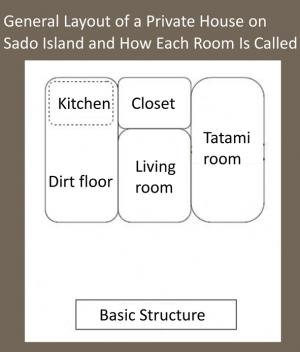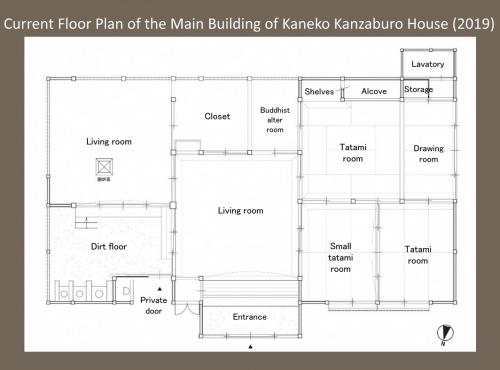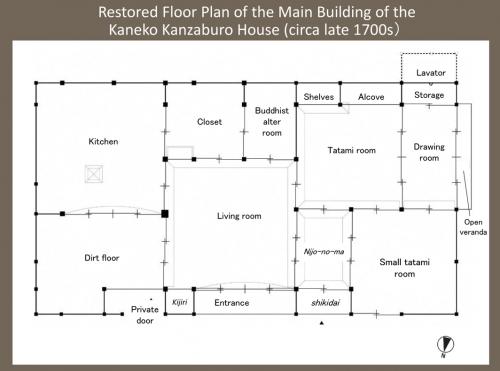本文
【金子勘三郎家】 パネル3(Part 3)
其の三 金子勘三郎家主屋の特徴
現在の間取り
佐渡の一般的な民家では、中央部に居間と寝室があり、居間の右側に座敷各室が、居間の左側に土間や台所が配置されるのが特徴です。
修理工事前の2019(令和1)年当時の金子勘三郎家主屋も、これとほぼ同様の間取りとなっています。
座敷部分は4部屋で構成され、その裏手に「ベンジョ」が、居間の前面に張り出した玄関が配置されています。
また、当家主屋では居間部分である「オイエ」とは別に、通常台所となる部屋を「オマエ」と呼んでおり、台所が居間的役割も有していたと考えられます。
これまでの調査で、当家主屋では鉱業から農業への生活・生業の転換に伴い、間取りの改造や増改築が行われていることがわかりました。
そこで、修理工事にあたっては、2019年当時の間取りを基準とし、建築当初からの改修の痕跡をわかりやすく示すことを基本方針としました。
間取りの復原
それでは、建築当初(1700年代後期頃)の当家主屋の間取りの復原平面図をみてみましょう。
まず、「ザシキ」と「ショイン」(※1)の北側には、「ニジョウノマ(ツギノマ)」(※2)と「コザシキ」が配置されています。「ニジョウノマ(ツギノマ)」の北側には「式台」(※3)が設けられ、外への出入口であったことがわかります。
また、「ショイン」の西側には「濡縁」(※4)があり、ここからも出入りが可能であったと考えられます。
なぜ、座敷部分に外への出入口が設けられたのでしょうか。
次のパネルと、実際に各部屋をみながら、その理由を考えてみましょう。
- ※1 ショイン
- 書物を読み書きするための部屋
- ※2 ニジョウノマ(ツギノマ)
- 外から直接座敷へ出入りするための通路的役割の部屋
- ※3 式台
- 主に玄関と床の段差が大きい場合に設置される踏み台
- ※4 濡縁
- 家の縁部分から張り出した板敷きの通路
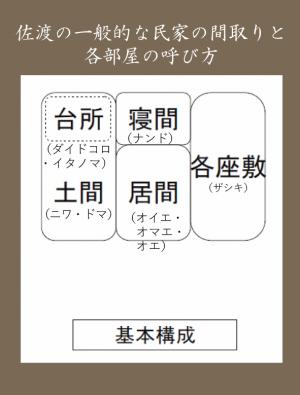
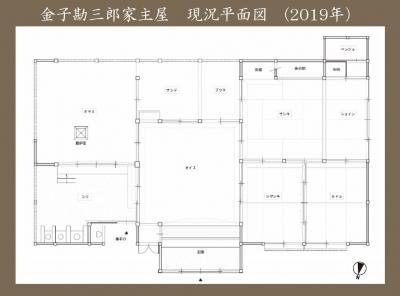
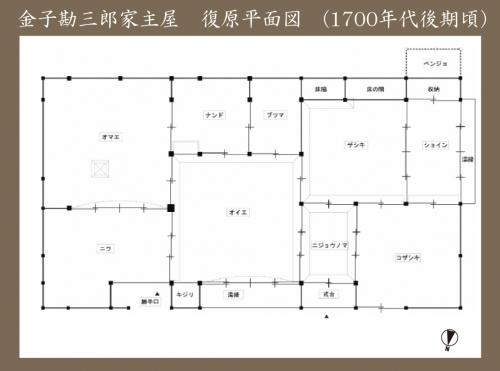
Part 3 Characteristics of the Main Building of the Kaneko Kanzaburo House
Present Day Room Layout
Most of the traditional private houses in Sado have a living room and a sleeping room in the center, an area of Japanese-style tatami rooms called zashiki located to the right of the living room, and a dirt-floor space and kitchen to the left of the living room.
The main building of the Kaneko Kanzaburo House had a similar layout until 2019, when it underwent repairs.
The zashiki area is comprised of four rooms, with a lavatory called a benjo behind it, and a raised entryway was added to the front of the living room.
In addition to the living room of the main house, which was called the oie, the kitchen was called the omae and is thought to have usually functioned as a living room as well.
Investigations have revealed that the alteration of the layout and the expansion and reconstruction of the main building were carried out following the changes to the residents’ lifestyles and occupations with the shift from mining to agriculture.
As a result, when repairs were carried out on the house, the 2019 layout was used as a base and the repair works were carried out in a way that clearly demonstrate the previous additions and changes to the house since its construction.
Restoration of Floor Plans
Now, let’s take a look at the restored floor plans of the main building from around the late 1700s, right after it was built.
First, to the north of the zashiki, a large tatami room, and the shoin*1, a drawing room1, are the nijo-no-ma (also called a tsugi-no-ma) *2, which is a small tatami room2, and the kozashiki, a sleeping room. On the north side of the nijo-no-ma (tsugi-no-ma), a low wooden step called a shikidai*3 was built, which indicates that this space was used as a doorway to the outside of the house. A nure-en, an uncovered wooden walkway*4, was located to the west of the shoin, which also functioned as an entry and exit. So why did the zashiki have side doors that led outside?
Let’s read the next panel and look at each room to find out why.
- *1 Shoin:
- a drawing room, a room for reading or writing.
- *2 Nijo-no-ma (Tsugi-no-ma):
- a small room used for passing through directly to the zashiki tatami room from the outside.
*3 Shikidai:
- a low wooden step installed when there is a significant height difference from the ground outside to the raised entryway step.
*4 Nure-en:
- an open veranda or raised wooden floor passage that runs along the outside of a house.
